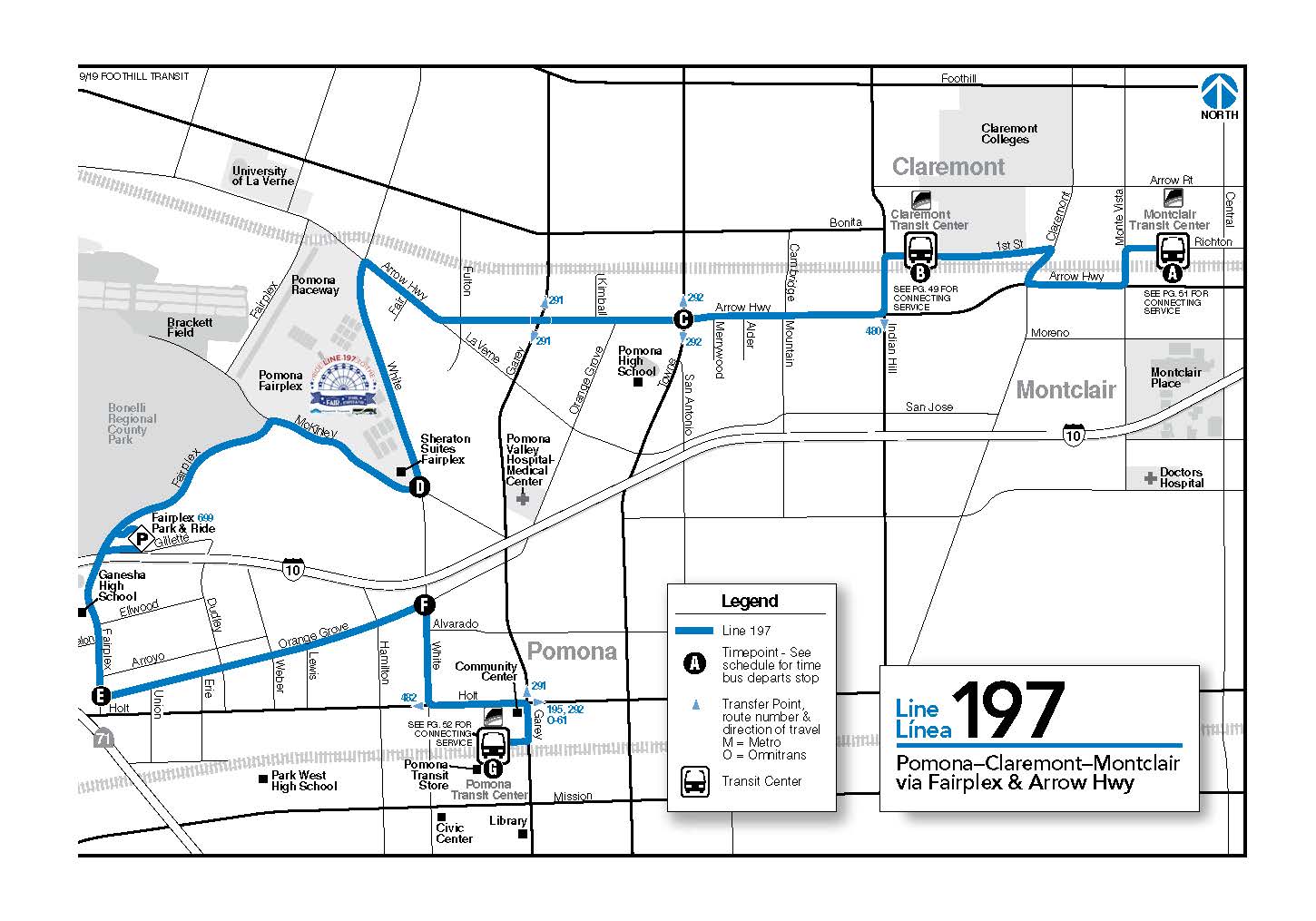Got the Munchies?: South L.A. Market Conversion Project Takes Unique Approach to Health
1:42 PM PDT on April 11, 2014
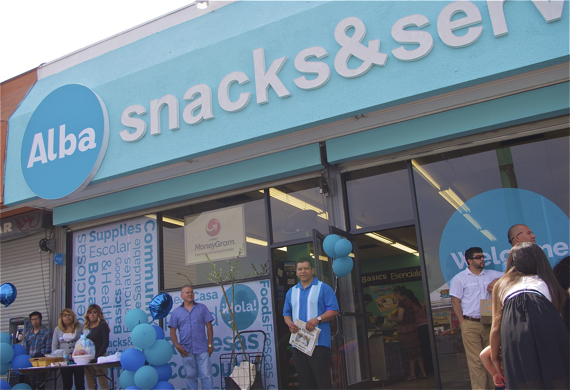
I first met Nelson Garcia almost two years ago at an L.A. Food Policy Council (LAFPC) training event for small business owners looking to transform their stores into healthier community resources.
He did not remember this when I mentioned it to him at the grand re-opening of his newly renamed Alba Snacks & Services store at 60th and Vermont in South L.A. last week.
That's not surprising.
I had attended the training to familiarize myself with the corner market landscape. He had attended because his businesses are his life.
He, like many there that day, had been focused on absorbing as much information as possible from the variety of presentations aimed at walking business owners through the steps of the market makeover process. And, in the debriefing session at the end of the day with LAFPC Director of Policy and Innovation Clare Fox, he had been eager to speak about the hurdles he faced making the suggested investments in his store.
The permitting process to sell produce was lengthy and expensive, he and others had lamented. The Department of Public Health (DPH) required that they have certain equipment in order to properly store produce, and the costs of acquiring it (plus the permits) were often more than owners in low-income communities could scrape together at once.
Or, as another owner complained, the interface with DPH could be confusing. They might hear from one inspector that they needed a particular piece of equipment, only to purchase it and later hear from another that it was the wrong one or that they had been misinformed about proper placement/spacing of equipment within the storage area.
It was a lot of trouble to go through for a product with a very limited shelf life and profit margin, and which begins to lose value the moment it goes out on the floor.
Their conclusions were disheartening to hear -- Garcia and the other participants clearly had the desire to sell something better than flaming hot finger snacks to the good people of their communities. But it was also clear that they wouldn't necessarily be able to get from A to B on their own.
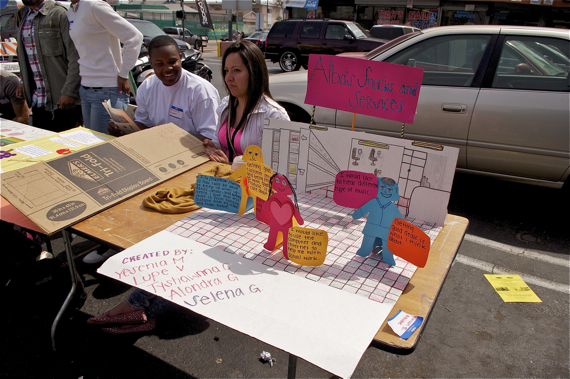
Enter the Food Policy Council.
The LAFPC took on much of the market makeover work that had fallen on the shoulders of the Community Redevelopment Agency (CRA) before its dissolution in 2011. Although unable to provide the level of funding the CRA might have granted to a market (up to $75,000 in some cases), the LAFPC has been able to assist owners in building their capacity via the Healthy Neighborhood Market Network (HNMN) and Community Market Conversion (CMC) programs.
Via quarterly sessions, the HNMN offers business owners a support network, business development training opportunities (i.e. marketing, product handling, merchandising, store design and layout, procurement, etc.), technical assistance, leadership training opportunities, and referrals to financial resources. Those participating in the HNMN also have the opportunity to qualify for (or at least network with those enrolled in) the CMC program. First piloted under the CRA, the CMC offers owners more intensive and tailored one-on-one assistance in taking the next steps to implement their makeover plans.
Even with all that aid, it really takes a business owner with a plan and the wherewithal to see it through to make a conversion project happen, several people involved in the HNMN told me.
That person, according to them, was Nelson Garcia.
They weren't kidding.
I would like to have 10 stores, Garcia told me in Spanish.
Ideally, he said, they would be near schools, they would offer healthy snacks, computers, reliable Internet access (a rare commodity in the area, even at the schools), and other services, and they would become community partners in the economic development of the area.
It's not the typical approach to such conversion projects -- which often look more narrowly at bringing fresh produce into "food deserts" or "food swamps" like South L.A. -- but Garcia was very clear on who his customers were and what they were likely to purchase.
Fifty percent of his business was services (i.e. moneygrams), he told me. The other fifty percent was largely comprised of hungry students from nearby Augustus Hawkins High School and the middle school next door.
He recognized he didn't need to try to compete with the large grocery store a few blocks north on Slauson, which met the needs of people looking to prepare meals. Instead, his niche would be to offer the kids a healthier selection of snacks, fruits, and drinks. And, he could secure a customer base by creating a clean and safe mini-computer lab where students could have Internet access to do homework or connect with friends. In turn, those students -- particularly those from Augustus Hawkins -- could help him with marketing, social media, and community outreach, and design some of the health-related signs to go up on his walls.
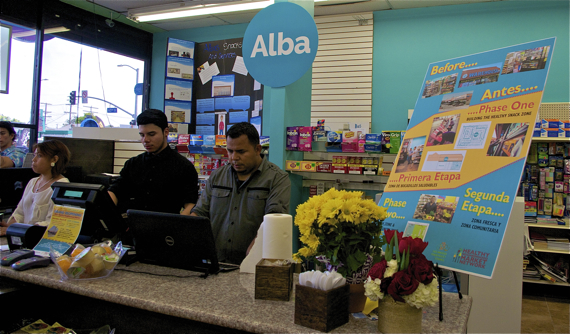
That plan has worked out well so far.
Early on in the process, the LAFPC and LURN (Leadership for Urban Renewal Network) helped connect him with teachers at Augustus Hawkins' RISE school (Responsible Indigenous Social Entrepreneurship). Students in the geography class there focused their service learning project on identifying community assets and deficits, surveying potential customers on foods they would be likely to purchase, and campaigning to get the word out in the community about health and the market's pending transformation. They've also aided in securing agreements from athletic teams, teachers, and other major community assets, such as St. John's, to buy healthier snacks for their teams or meetings in order to help make the makeover sustainable.
Comprehensive projects like these are important, Garcia explained, because of the positive cycle of investment they create in the community: he invests money in local hardware and supply stores for the upgrades to his store, he offers a better (and slightly pricier) selection of goods and services in a better setting, he draws more customers, which allows him to offer a wider range of services and hire more local youth, and he pays more in taxes which, in theory, should come back to his community.
If you don't stop me, I can go on all day about this cycle, he laughed.
It all made such perfect sense. Yet, getting hold of the capital that would help him take these steps was far more challenging than it should have been, especially for someone who was as well-prepared as he was.
He had a great set of short- and long-term business plans.
He had also truly benefited from the free consultations he had had with Michael Powell of Shook Kelley, a strategy and retail design firm, and others regarding branding, color schemes, and reorganization of the store to highlight a healthy snack zone.
I wouldn't have thought of those things on my own, he said, but he liked how they set him apart from other corner stores in the area, giving him a marketable brand and image.
And, he had gotten the help he needed in sourcing healthy snacks and building relationships with vendors. (According to Powell, it is a piece of cake to get Frito Lay to deliver to your store, but much harder to track down specialty snacks like KIND bars.)
But trying to work with community development institutions to get financing proved too slow and cumbersome a process.
Instead, most of the approximately $30,000 he invested in the makeover had come from his own pockets or those of friends and family.
And, while he was deeply appreciative of relatives that loaned him $500 or other small amounts, they often needed the money back within a few weeks' time. Given that he worked on the first stage of the makeover for a year or more, having to constantly cobble together and juggle funds over much of that period created a lot of unnecessary stress.
He was able to get some assistance via a zero-interest loan with the online funding platform KivaZip, he said, but the maximum amount he could raise was $5000.
Pointing to the new floors, the new refrigerators, the new paint scheme, the new computers, and new electrical wiring, and ticking off the cost of each, "$7000, $8000...," he suggested that if the city wanted to be genuinely supportive of projects that promised to be real assets to the community, they had to find a way to offer people easier access to more stable sources of financing.
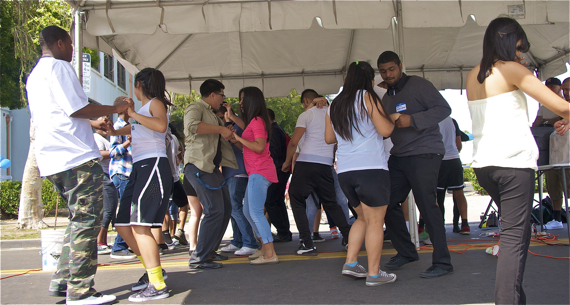
That seems to be something the city understands.
The draft Plan for a Healthy L.A. speaks broadly of the need for the city to "capitaliz[e] upon existing community resources like corner neighborhood markets or healthy mobile or cart vendors" and looks to the still-evolving Economic Workforce and Development Department to take leadership on helping business owners access financial, technical, and other forms of assistance.
It isn't wholly clear, however, that the Plan grasps the importance of community partnerships in sustaining a business or the notion that what makes a store a "healthy" resource may be much more than just food. In lower-income communities where people have very limited resources to spend, evidence that a business owner genuinely cares about their neighbors' well-being can be what adds real value to the healthy products the store offers.
Take the case of Central Avenue's 3 Worlds Cafe, a partnership between Kogi truck proprietor Roy Choi, the Coalition for Responsible Community Development, and Jefferson High School. They train and employ at-risk youth, offer healthy smoothies and juices, host open mics, and provide Internet access. You can also usually find them doing smoothie demonstrations at just about every health or street fair that happens in the area.
Their commitment to health and community along with the provision of a much-needed service has helped the cafe become a regular meeting site for groups looking to collaborate on bringing positive, home-grown change to the neighborhood.
Projects like these that have the potential to genuinely engage and better the community, LAPFC's Fox says, "should be no-brainers" for the city to invest in.
My customers keep telling me my store is "uncommon," Garcia said. It's true, it's uncommon. And that's a good thing.
Sahra is Communities Editor for Streetsblog L.A., covering the intersection of mobility with race, class, history, representation, policing, housing, health, culture, community, and access to the public space in Boyle Heights and South Central Los Angeles.
Stay in touch
Sign up for our free newsletter
More from Streetsblog Los Angeles
No, L.A. City Does Not Always Add Required ADA Ramps During Resurfacing, But They Should
StreetsLA GM Keith Mozee "Any time we do street resurfacing, it is considered an alteration, which requires ADA ramps to be installed."
LAPD Was Crossing Against Red Light in Crash that Killed Pedestrian and Injured Six in Hollywood
The department says the officers had turned on their lights and sirens just before crossing, but won't say why they did so.

